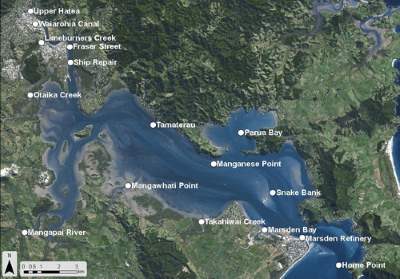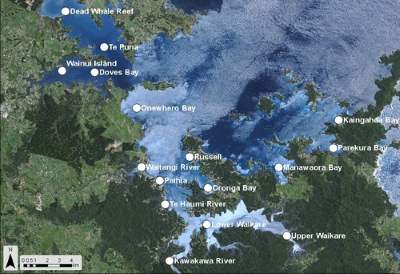Coastal Sediment Monitoring Programme
Northland Regional Council monitors sediment metal concentrations and the physical characteristics of sediments every two years, at 16 sub-tidal sites in Whāngārei Harbour and the Bay of Islands. The sites have been selected in order to capture the main freshwater inputs and to ensure a good geographical spread.
Sediment samples are analysed for sediment grain size – the proportion of mud – and concentrations of total cadmium, total chromium, total copper and total zinc. Concentrations of metal contaminants are assessed against the Australian and New Zealand Guidelines for Fresh and Marine Water quality (ANZECC guidelines).
Whāngārei Harbour
Click the image below to view a larger version in pdf format (224 kb)
 Figure 1: location of sub-tidal sediment sampling sites in Whāngārei Harbour in 2010.
Figure 1: location of sub-tidal sediment sampling sites in Whāngārei Harbour in 2010.
In 2010-2011, metal concentrations in sediments in the Whāngārei Harbour were within guideline levels at all sites, except for zinc concentration measured in the Waiarohia Canal.
Sediments collected from tidal creeks in the upper Whāngārei Harbour, Hātea River and Otaika Creek, generally had higher proportions of mud and metal concentrations. These patterns are as expected because tidal creek environments usually act as sediment traps and metal contaminants are attracted to mud.
Bay of Islands
Click the image below to view a larger version in pdf format (251 kb)
 Figure 2: location of sub-tidal sediment sampling sites in Bay of Islands in 2010.
Figure 2: location of sub-tidal sediment sampling sites in Bay of Islands in 2010.
Metal concentrations recorded in sediments collected from the Bay of Islands were all within guideline levels. Sediments collected from tidal creeks, such as Kerikeri Inlet, Kawakawa River and the Waikare Inlet generally had higher proportions of mud and metal concentrations, with lower proportions of mud and metal concentrations recorded in more exposed locations, such as Onewhero Bay.
